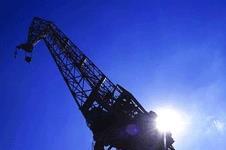Coroner to write to minister to warn of inadequacy in rules after HSE finds crane was in compliance
A fatal crane accident caused by high winds in Liverpool last year has raised the need to revise European safety standards, after a court heard that no safety rules were broken and that such an accident could recur in similar wind conditions.
The Liverpool coroner, Andre Rebello, is to write to the responsible government minister, under section 43 of the Coroner's Rules, to alert him to the danger.
Rebello said: “I will be writing to Lord McKenzie, who is the under-parliamentary secretary of state for work and pensions, regarding the safety standards of the crane. It is up to him to decide whether to raise this matter with the European safety authorities.”
The tower crane toppled over on a building site in the city’s Seel Street in January 2007, killing Polish construction worker and father of two Zbigniew Swirzynski.
Swirzynski died instantly when he was crushed by a huge concrete block counterweight that plunged to the ground as the crane collapsed.
The Health and Safety Executive (HSE) told that court that the crane was the proper one for the job, correctly set up and used according to the European standards.
Its investigation found that the crane’s collapse was caused by a steel rope jumping off a pulley wheel when hit by a gust of wind, despite it being fitted with a safety bar.
An inspector told Liverpool coroner’s court how the 39m-high crane was lifting a light load on 15 January last year when a short gust of wind blew back the lifting jib of the crane.
This caused the 18mm steel rope on the Spanish-built machine, belonging to Norfolk-based Falcon Cranes, to come off a pulley and become tangled.
The court heard that the six-year-old crane was also fitted with an alarm set to sound if there was a gust of wind above the safe operating level of 70kmph lasting more than three seconds.
Several witnesses confirmed that no alarm sounded, and inspectors concluded that the gust must have been about 82kmph but lasted only one second.
The crane driver, Barry Walker, was unaware of the tangled rope and when he tried to lower the crane the 6-tonne steel jib collapsed to the ground.
As the jib broke loose the crane became immediately unbalanced and the entire tower was pulled over, sending five 2.5-tonne concrete counterweights plunging to the ground.
The crane driver escaped serious injury but one of the five counterweight slabs hit Swirzynski.
HSE principal specialist inspector Geoff Frackelton showed the jury a computer-animated reconstruction of the incident.
Frackleton said: “Three experts have concluded that the crane is likely to have been hit with a gust of wind 10kmph above its limit, but only for a second. This would not sound an alarm to alert the driver… It is this gust of wind that pushed the crane jib, which was in a near vertical position too far back, forcing the rope out of its pulley.
“All cranes have to meet European safety standards which have a clause that states a safety bar is positioned across the pulleys to prevent the ropes coming loose. We found the crane satisfied all the standards for its use in this country. This was the proper crane for the job, properly set up and correctly used according to the European standards.”
He added: “On this crane the safety measures included a bar which left a 4mm gap between the pulley and the bar. In exceptional circumstances the rope can become so taught that it can flatten out and would fit through this gap.
“These cranes are still being sold and still being used with no changes to the safety standards. We can’t control the wind and if it has happened once it can happen again.”
The coroner’s jury of four women and seven men returned a verdict of accidental death.




























No comments yet